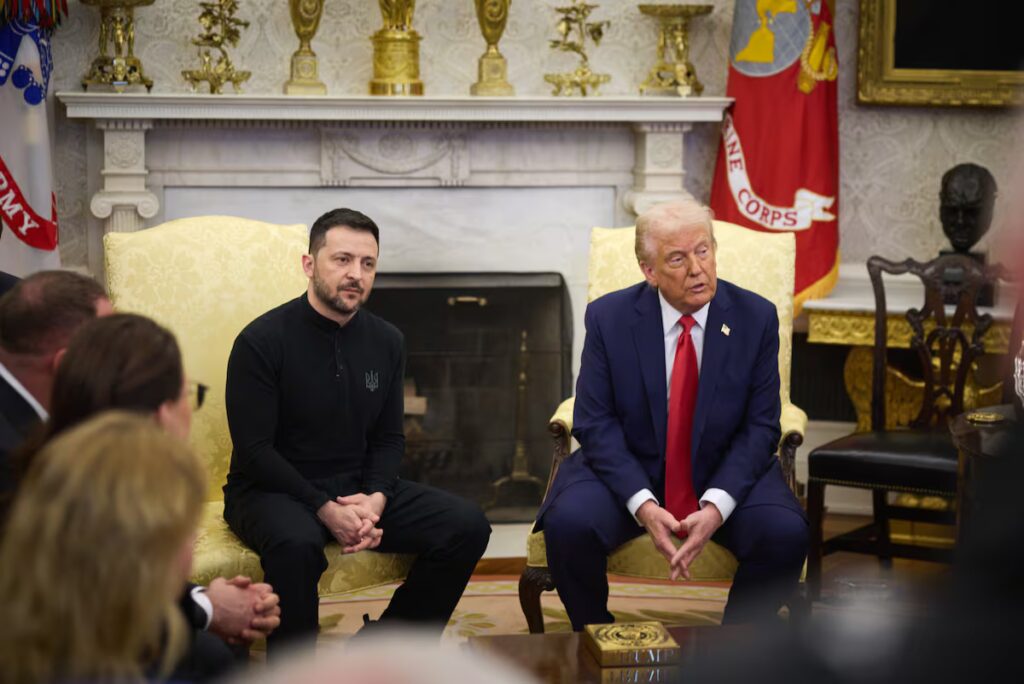
The relationship between Volodymyr Zelenskiy and Donald Trump resembles a grueling tennis match. After months of blows, the Ukrainian president finds himself with his back against the wall at the back of the chamber, saving points at the last minute. The US president wants to claim victory as the man who brokered peace between Moscow and Kiev. And his strategy is to subdue the weakest opponent until he surrenders. While Trump accused Zelenskiy on social media on Sunday of being ungrateful and responsible for the war, the Ukrainian leader’s emissaries saved another rallying point in a meeting with the Americans in Geneva.
The Ukrainian delegation managed to convince the White House to temporarily review the so-called “peace plan” in the Swiss city. This document, made public last week, caused a major upheaval in Western foreign ministries and in Kiev. The text was drafted in October by Kirill Dmitriev, businessman and close confidant of Russian President Vladimir Putin, and Steve Witkoff, Trump’s special envoy for relations with the Kremlin. The plan was received in Ukraine as a humiliation: “A loss of dignity,” in Zelenskiy’s words, since it is mainly a list of concessions to the invader.
The Geneva meeting has made it possible, for the moment, to eliminate from the plan some of the red lines that Kiev refuses to cross. These include, among others, according to a leak published by Ukrainian media RBC and the Financial times – the points that would have forced Ukraine to cede sovereignty over Crimea and the Donbas region, that would have forced Kiev to reduce the size of its armed forces and that would have required the Constitution to declare that Ukraine renounces NATO membership.
The statement on the conclusions of the Geneva meeting indicates that the final plan and the debate on these issues, which have so far deviated from the script, will have to be decided in the coming days between Trump and Zelenskiy. In other words, a new game in which the Ukrainian president will have to save the situation.
Minerals, a rabbit out of a hat
Trump arrived at the White House in January after a campaign in which he promised to end the war within days and end what he called unnecessary military aid to Ukraine. Anticipating this threat, Zelenskiy pulled a rabbit out of the hat in September 2024, during his first meeting with Trump, then still a Republican candidate: he proposed that, if elected president, the United States would maintain its military support in exchange for control of Ukraine’s mineral wealth. In February 2025, a month after his return to power, Trump accepted the offer: he asked for the minerals deal in exchange for a willingness to negotiate a defense support plan for Ukraine.
The minerals deal was supposed to be signed during the ill-fated Feb. 28 meeting at the White House, where Zelenskiy, Trump and his vice president, J.D. Vance, got into a heated argument in front of the media. The US president responded by temporarily blocking all military assistance to Ukraine, including as crucial as intelligence.
Zelenskiy saved his position – as he himself acknowledged – thanks to the advice he received from British Prime Minister Keir Starmer and French President Emmanuel Macron.
Kiev’s strategy has shifted to a campaign of appeasement and flattery towards Trump, downplaying his mood swings. This, however, did not prevent further crises. In July, for example, the Pentagon decided to suspend the arms transfer approved during Joe Biden’s presidency. Zelenskiy managed to defuse the situation after another tense phone call with Trump.
The Ukrainian leader has not always managed to keep up with Trump’s maneuvers. Zelenskiy was not informed of the meeting that Russian Foreign Minister Sergey Lavrov and US Secretary of State Marco Rubio were supposed to hold last February in Saudi Arabia. The Ukrainian leader was supposed to travel to Riyadh, but canceled the trip after learning of the meeting, the first in which Washington reopened the door to international recognition of Moscow.
But the biggest bitter pill that Kiev and its European allies had to swallow was the summit with full state honors that Trump organized for Putin last August in Alaska. The Russian autocrat was welcomed as a world leader and not as a politician wanted by the International Criminal Court.
Decisive autumn
Trump has maintained a carrot-and-stick approach with Putin and Zelenskiy, although the stick has been more prevalent with the Ukrainian leader. Relations became tense again last October, once again at a meeting at the White House. Witkoff and Trump made it clear to the Ukrainian leader that the time had come to accept the cession of the territories conquered by Russia. The meeting came two days after Trump spoke by phone with Putin, with plans to hold another summit, this time in Hungary.
The European diplomatic machine has been mobilized once again to protect Ukraine’s interests and convince Washington that Russia accepts that any peace negotiations must be preceded by a ceasefire. And Trump, for the first time, stood up to Putin: he suspended plans for the Budapest summit and approved the first sanctions of his presidency against the Russian economy.
A few days after this, Dmitriev and Witkoff were negotiating the 28-point peace plan that caused a diplomatic storm in Europe. Zelenskiy will try to survive, once again, in another face-to-face meeting with Trump in the coming days.
Sign up to our weekly newsletter to get more English-language news coverage from EL PAÍS USA Edition





